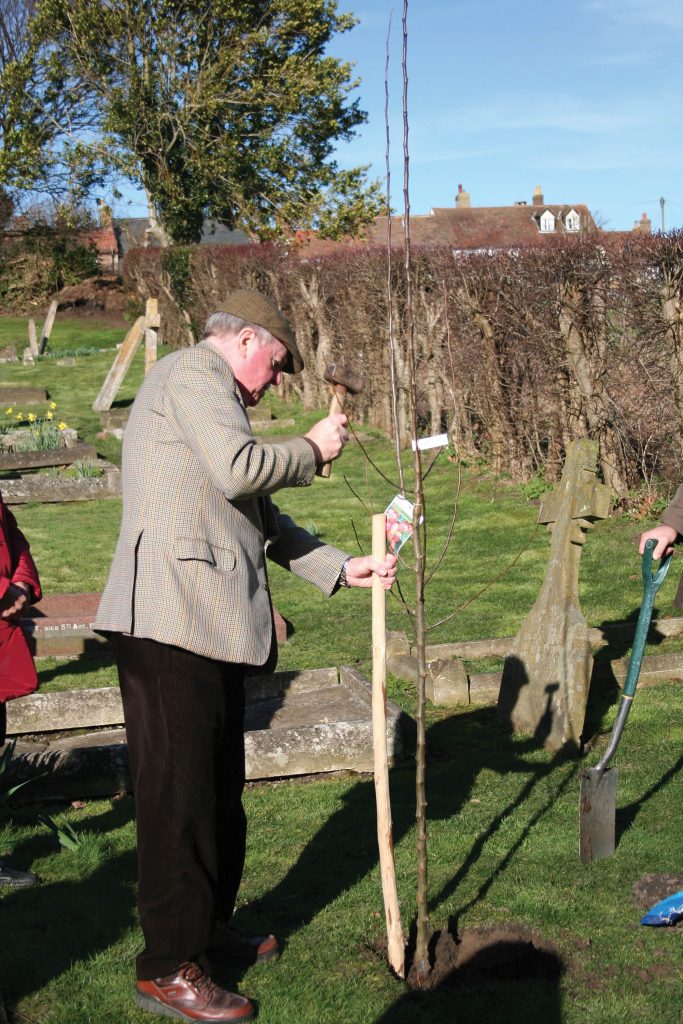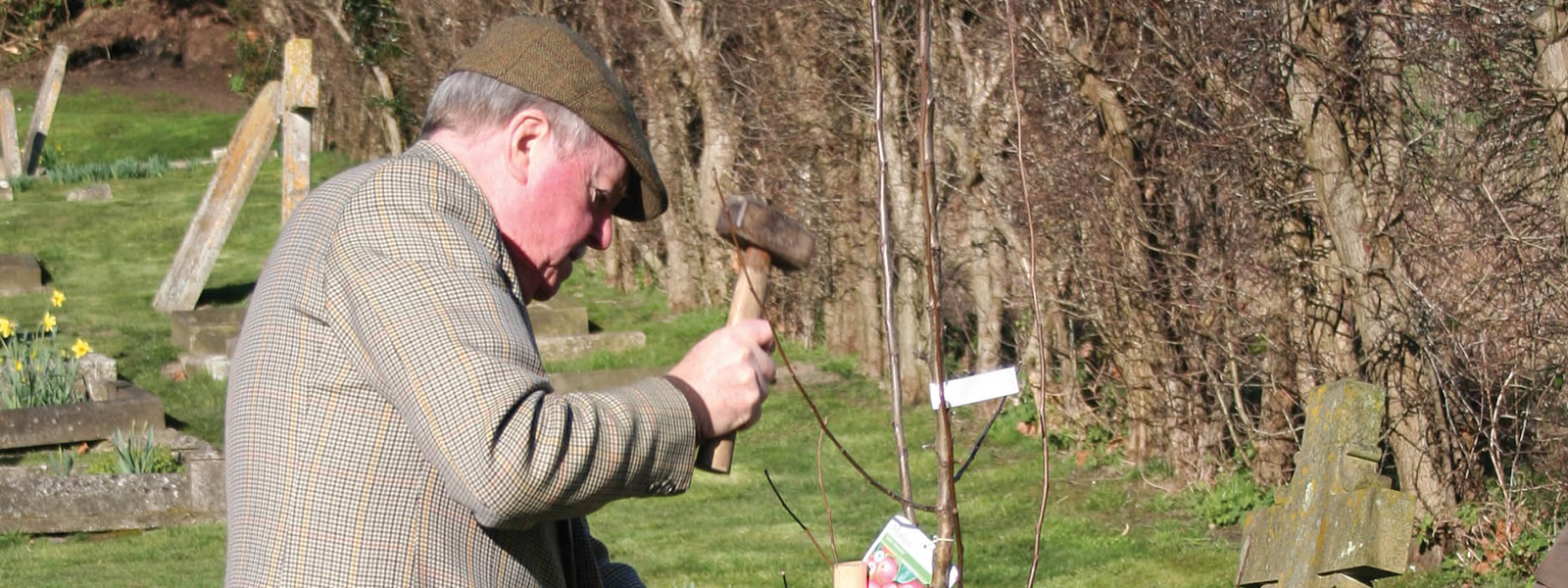Tips for growing trees
Impartial Advice from the Tree Advice Trust
“The tree which moves some to tears of joy is in the eyes of others only a green thing that stands in the way……”
(William Blake. Letter to the Rev. John Trusler. August 1799)
What can you grow in your garden?
“An Englishman’s home is his castle” –
There are, generally, no restrictions on what trees you may plant and cultivate on your land. Trees don’t understand boundaries though and their roots and branches go where they like. Your neighbour may not have as much enthusiasm for your tree as you do!
Reference: Trees and Hedges in Dispute. Arboricultural Practice Note 11 (AAIS 2005)
The perfect tree?
The perfect tree grows swiftly to its desired height and shape and immediately stops growing. It flowers prolifically, has beautiful autumn colours and then shows its winter bark and twigs. Sadly, no trees do all of this. Trees change over time and whilst they don’t last forever they generally outlive people. Tree planting is an opportunity to change the future appearance of your garden but it needs a bit of careful forethought. There’s no harm in planting more trees than will ultimately fit in your garden or planting species that will eventually outgrow the available space but you will probably need to be ruthless and cut some down before maturity to give room to others.
Reference: Choosing the right tree for your garden. Arboricultural Association Leaflet
What do trees really want?
Trees can grow happily with their roots in nothing more than brick rubble, but if they could talk they would probably tell us they want to live in a woodland with natural soil where there are no lawns and lawnmowers and no herbicides, where they are safe from hungry animals and where their fallen leaves are recycled into the soil every year. So how can we make them feel at home in gardens? Put good organic mulch under their crowns if possible – it improves the soil structure, keeps grass away and also prevents damage to roots and trunks from grass cutting machinery.
Reference: Woodchips as a mulch or soil amendment. ARIN 123/94(AAIS 1994)
Why do some newly planted trees struggle to get going?
They say that moving home is one of the most stressful times in a person’s life. The same is true for young trees whose roots have been cut and exposed to the elements before being put into a soil that is far different from the controlled rooting medium the nurseryman grew them in. Most trees bought by gardeners will have been grown by the nursery in pots. When buying a tree, make sure it has not been in the pot too long (roots circling round the inside of the pot are not good). Transplant the tree to its new site on a damp, drizzly, still, mild day in winter. Don’t expose the roots for very long and make sure they are not planted deeper than they were growing in the pot.
Reference: Tree Planting. Arboricultural Association Leaflet
We all need support when growing up don’t we?
Unless your garden is very exposed or you are planting trees with heavy crowns more than 2 metres tall then you probably don’t need to stake your tree. If the tree needs to be staked because its trunk is bending you have probably bought a poorly formed tree. Excessive staking stops young trees developing sturdy stems. If you are worried about your new tree uprooting in the wind, use a low stake (no more than 500mm out of the ground) and use a flexible tie to allow some movement of the trunk. Trees should only need to be staked for one or two years. Don’t forget to remove the stakes and ties once they are redundant as they can cut into and strangle the expanding stems of the trees.
Reference: Stakes and Ties. ARN 77/89(AAIS 1989)
Growing in the right direction.
A little training when young can make a big difference to our lives. If you want your tree to grow with a straight trunk and good branching structure, prune it carefully when it is young to remove big low branches and twin stems. Unchecked, these are likely to lead to future problems and may shorten the life of your tree.
Reference: Young Tree Maintenance. Arboricultural Association Leaflet
We are not alone.
As they grow, trees quickly become a habitat for many species of animals, fungi and plants. Most trees support an abundance of insects which in turn support birds, bats and other creatures that feed on them. But its not just about insects and animals, in these days of reduced industrial pollution, lichens and mosses, which don’t cause any harm to trees, are making a comeback on garden trees and are usually an indication of better air quality. Gardeners can use trees to support climbing roses or clematis. Sometimes vigorous climbing plants such as ivy find the trees to their liking. Ivy only uses trees for support but it can smother small, and sometimes even large trees. Don’t let ivy grow high into the crowns of trees but if it is just on the trunk then it is doing no harm and is a great wildlife habitat.
Reference: Ivy – Boon or Bane. APN10 (AAIS 2004)
Bleeding trees!
Some trees bleed sap when pruned in early and mid spring. Walnuts, maples and birch are renowned for this and the sap flow can be prolific and alarming. Don’t worry though; little if any harm is caused to the tree by this type of bleeding. As a general rule pruning is best done on frost-free days in winter or in midsummer. Avoid pruning most species of trees in mid-spring and in autumn. Don’t prune old trees heavily in periods of drought or in the year following a very dry summer.
Reference: Choosing the time of year to prune trees ARN 117/93(AAIS 1993)
Reference: Trees Bleeding APN8 (AAIS 2004)
A Matter of Life and Death.
Young trees that are not under any stress rarely succumb to disease. The most valued and venerated trees are however those that are large, old and full of character. These are the trees that are often associated with decay fungi that rot away the heartwood. Understanding tree diseases is particularly important for garden owners whose investment is usually in a few special trees. The Tree Advice Trust’s premium rate advice line (Tree Helpline 09065 161147) records give us an insight into which diseases are of most concern to tree owners. The top ten currently are:
- Honey fungus
- Horse chestnut Bleeding canker
- Horse chestnut leaf miner
- Phytophthora
- Root Rot (including Sudden Oak Death)
- Oak decline
- Fungal wood decays
- Cypress aphid
- (Leyland cypress hedges)
- Damage caused by mammals (deer, rabbits)
- Mechanical damage (lawnmowers and filament trimmers)
- Herbicide, chemical and salt poisoning.
Reference: Tree Damage Alerts – free, published by AAIS

Are you safe?
People worry about the risk of trees falling but in reality the risk is very low. On average in Britain only five or six people are killed by falling trees per year. This puts the risk per person at about one in ten million in any year. Assuming exposure to risk is equal, you have better odds of flipping a coin and getting 23 consecutive heads. Low risk is, of course, no reason to be complacent. If you own large old trees near to your house, neighbour or to a road you should get them checked regularly by a tree expert. You are far more likely to be injured pruning a tree than by a falling tree! Whilst it is so temptingly convenient, don’t prune trees from a ladder. Ladders are for climbing and are not designed as a working platform.
What does the future hold?
Whether you believe it to be caused by man or not there is overwhelming evidence that the climate in Britain is changing. How will this impact on trees that you plant today? It is predicted that the climate in Britain may become milder, stormier and wetter in winter and hotter and drier in summer. The pace of change is expected to easily outpace the ability of tree species to respond to the changes by genetic adaptation but will this mean our land will become unsuitable for our favourite trees?
The impact of climate change is predicted to be most noticeable in the south and east of England. Summer drought could reduce the growth of trees generally and lead to higher numbers dying from stress related disease. Waterlogging of soils in winter may result in root death. Those trees growing in man made environments such as streets and gardens may be affected more severely than those growing on natural soils and in woodlands.
Of the common tree species, English oak (Quercus robur) is thought likely to tolerate the changes well but Sessile oak (Quercuspetraea) may decline in the southern part of Britain. Ash (Fraxinus excelsior) may be well suited to the changes, but beech (Fagus sylvatica) may not. In general trees originating from hotter and drier climates may become more suitable in the south of England but with these species there is an increased risk of spring frost damage.
Climate change will not only affect the growth of trees but will also affect the relationship between trees, insects and fungi. The relationship between pest species and trees is likely to change in unusual ways. Milder winters may favour insects such as aphids and some fungi may extend their range and become more problematic in Britain.
The best general advice we can give is to plant a wide range of species, preferably choosing those that are well suited to the soils and climatic conditions of thesite. Plant species that are well inside their overall climate range. Make sure that they grow in good soil, keep grass away from their trunks and preferably cover the ground underneath their branches with organic mulch.
“……Some see nature all ridicule and deformity,.. some scarce see nature at all. But to the eyes of a man of imagination, nature is imagination itself.”
(William Blake. Letter to the Rev. John Trusler. August 1799)
The Tree Advice Trust
(Impartial Advice on Amenity Trees)
Alice Holt Lodge, Wrecclesham, Farnham, Surrey
01420 22022 (for publications and tree consultancy)
Tree Helpline 09065161147 (Premium Rate line for consultancy)
Tree Damage Alerts (free) Arboricultural Practice Notes (APN) and Arboriculture Research and Information Notes (ARN and ARIN) are published by the AAIS which is part of the Tree Advice Trust.
The Arboricultural Association (www.trees.org.uk) publishes a range of information leaflets on growing and managing trees.
The Tree Advice Trust provides advice, information and guidance on the cultivation, management and care of trees and shrubs grown for ornament and enjoyment to raise the standards of practice in UK.
Text prepared by Ben Holding, Arboricultural Advisory and Information Service

